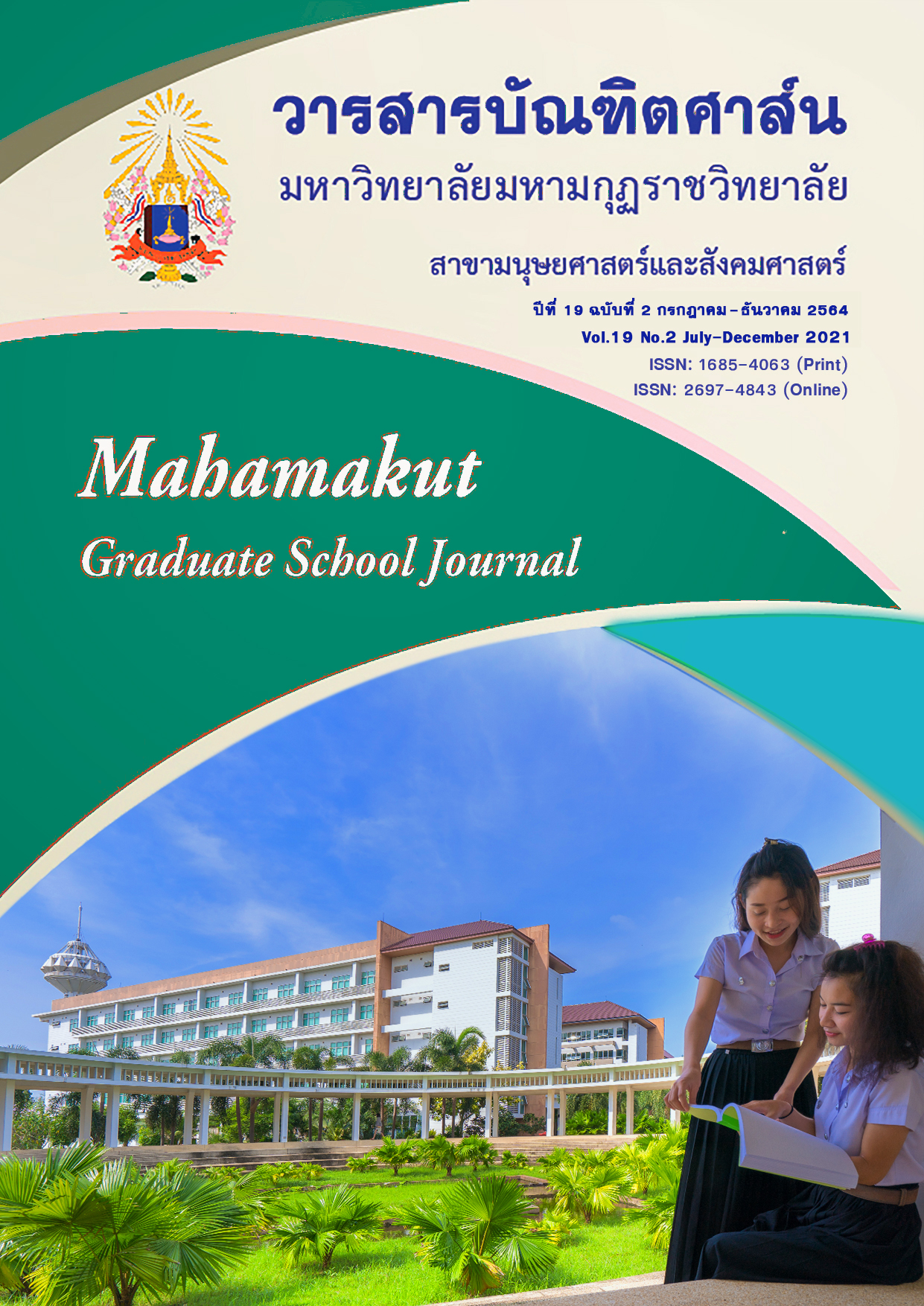การดำเนินชีวิตในศตวรรษที่ 21 ด้วยหลักพุทธสุนทรียศาสตร์
คำสำคัญ:
การดำเนินชีวิตในศตวรรษที่ 21, หลักพุทธสุนทรียศาสตร์บทคัดย่อ
การวิจัยเรื่องนี้มีวัตถุประสงค์ในการทำวิจัย ดังนี้ 1) เพื่อศึกษาการดำเนินชีวิตในศตวรรษที่ 21 2) เพื่อศึกษาหลักพุทธสุนทรียศาสตร์ 3) เพื่อบูรณาการการดำเนินชีวิตในศตวรรษที่ 21 ด้วยหลักพุทธสุนทรียศาสตร์ 4) เพื่อนำเสนอองค์ความรู้ใหม่เรื่อง “การดำเนินชีวิตในศตวรรษที่ 21 ด้วยหลักพุทธสุนทรียศาสตร์” โดยใช้ระเบียบวิธีวิจัยเชิงคุณภาพ (Qualitative Research) ทำการวิเคราะห์เนื้อหาจากเอกสาร วิธีดำเนินการวิจัยเริ่มจากการวิเคราะห์เนื้อหาจากเอกสารทางวิชาการ วิเคราะห์หลักพุทธสุนทรียศาสตร์จากพระไตรปิฎก อรรถกถา และสัมภาษณ์เชิงลึก (In-depth Interview) ผู้ทรงคุณวุฒิ จำนวน ๒๐ รูป/คน และนำเสนอข้อมูลเชิงพรรณาวิเคราะห์
ผลการวิจัยพบว่า:
การดำเนินชีวิตในศตวรรษที่ 21 เป็นยุคอุตสาหกรรม วัตถุนิยม บริโภคนิยม ระบบดิจิตอล และเทคโนโลยีสารสนเทศ มีการนำความรู้ทางวิทยาศาสตร์มาทำคุณภาพชีวิตให้ดี แต่การบริโภคไม่ตรงตามจุดประสงค์ที่แท้จริงของเทคโนโลยีก็ให้โทษทำให้เกิดปัญหา 5 ด้าน คือ จิตใจ สังคม เศรษฐกิจ สิ่งแวดล้อม และเทคโนโลยี เพราะมนุษย์ขาดการพิจารณาตามความเป็นจริงและการคิดวิเคราะห์สิ่งต่าง ๆ ไม่ถูกต้อง
พุทธสุนทรียศาสตร์ เป็นคำสอนของพระพุทธเจ้าที่ว่าด้วยความงาม มีอยู่ 2 มิติ คือความงามมิติทางโลกและความงามมิติทางธรรม ความงามมิติทางโลกเป็นความงามที่ชาวโลกสมมติขึ้น จัดเป็นจิตพิสัย เพราะเป็นความงามที่เกิดภายใต้อำนาจของกิเลส ส่วนความงามมิติทางธรรมเป็นความงามจากการปฏิบัติธรรมแสดงออกทางพฤติกรรมทำให้งดงาม จัดเป็นวัตถุพิสัยเพราะเป็นความงามลักษณะอนัตตา หลักธรรมของพระพุทธศาสนา คือ ขันติ โสรัจจะ ไตรลักษณ์ ทิฏฐธัมมิกัตถะ กัลยาณมิตร และโยนิโสมนสิการ หลักธรรมเหล่านี้เป็นพุทธสุนทรียศาสตร์ เมื่อปฏิบัติแล้วย่อมเกิดความงามเป็นผลเสมอ เรียกว่า ชีวิตงาม
เมื่อนำหลักธรรมทั้ง 5 มาบูรณาการกับปัญหา 5 ด้าน ทำให้เกิดความงาม คือ 1) ขันติ โสรัจจะ อดทนอย่างมีสติทำให้จิตใจสงบนิ่ง ไม่ขุ่นมัว เกิดปัญญาเห็นเหตุปัจจัยและโสรัจจะเกิดตามเกื้อกูล ทำให้จิตใจงาม 2) ไตรลักษณ์ การเข้าถึงองค์ความรู้ เห็นตามความเป็นจริงว่าทุกสิ่งมีการเปลี่ยนแปลง คลายความยึดมั่น เกิดเอื้อเฟื้อ เผื่อแผ่ ไม่เห็นแก่ตัว ทำให้สังคมงาม 3) ทิฏฐธัมมิกัตถะ กิจกรรมในชีวิตอยู่ที่การทำงานมากที่สุดจึงต้องสร้างคุณธรรมควบคู่กับงาน ไม่ประมาท ฉลาดในการคบเพื่อน การบริหารเงินถูกต้อง มีการเงินมั่นคง ทำให้เศรษฐกิจงาม 4) กัลยาณมิตร การเป็นมิตรกับสิ่งแวดล้อมด้วยการเห็นคุณค่าและช่วยกันอนุรักษ์ เกิดดุลยภาพต่อกัน ทำให้สิ่งแวดล้อมงาม และ 5) โยนิโสมนสิการหล่อหลอมเทคโนโลยีกับมนุษย์ด้วยการคิดถูก รู้คุณค่าแท้ เป็นความรู้แห่งอารยชน ทำให้เทคโนโลยีงาม จากผลของความงามทั้ง 5 ทำให้เกิด GRACE MODEL โมเดลแห่งความงดงามแห่งความดี เกิดพฤติกรรม จิตใจ และปัญญางดงาม ด้วยการคิด พูด ทำ ทุกการกระทำเป็นไปอย่างดี จริง และมีประโยชน์ คือการดำเนินชีวิตที่งดงาม
เอกสารอ้างอิง
มหามกุฏราชวิทยาลัย. มูลนิธิ. (2536). พระไตรปิฎกและอรรถกถาแปลฉบับมหามกุฏราชวิทยาลัย (91 เล่ม). พิมพ์เนื่องในวโรกาสครบ 200 ปี แห่งพระราชวงศ์จักรี กรุงรัตนโกสินทร์ พุทธศักราช 2525. (พิมพ์ครั้งที่ 3). เล่มที่ 19, 30. กรุงเทพฯ: โรงพิมพ์มหามกุฏราชวิทยาลัย.
หนังสือ
เจมส์ มาร์ติน. (2010). โลกแห่งศตวรรษที่ 21. The Meaning of The 21st Century. (ภาพร, แปล), กรุงเทพฯ: ประพันธ์สาส์น.
เซียวฟง. (2546). 2 ลัทธิในรอบ 100 ปี ทุนนิยม & สังคมนิยม. (อรุณ โรจนสันติ, แปล). กรุงเทพฯ: สุขภาพใจ.
ธีรพงษ์ มหาวีโร และฝ่ายวิชาการ สำนักพิมพ์เดอะบุคส์. (2555). แผนพัฒนาเศรษฐกิจและสังคมแห่งชาติ ฉบับที่ 11 (พ.ศ. 2555-2559). กรุงเทพฯ: เดอะบุคส์.
พระมหาทวี มหาปญฺโ (ละลง). (2555). ความงามในพระพุทธศาสนา. กรุงเทพฯ: ภาพพิมพ์.
เสถียร โพธินันทะ. (2560). มรดกทางปัญญา. กรุงเทพฯ: มหาวิทยาลัยมหามกุฏราชวิทยาลัย.
วิทยานิพนธ์
พระมหาขันทอง วิชาเดช. (2545). การศึกษาวิเคราะห์เรื่องขันติในพุทธศาสนาเถรวาท. วิทยานิพนธ์ปริญญาศิลปศาสตรมหาบัณฑิต, สาขาวิชาพุทธศาสนศึกษา, คณะศิลปะศาสตร์, มหาวิทยาลัยธรรมศาสตร์.
พระมหาชัชวาลย์ ตคุโณ (จารย์คุณ). (2561). ศึกษาวิเคราะห์หลักธรรมในการดำเนินชีวิตของเศรษฐีในสมัยพุทธกาล. วิทยานิพนธ์ศาสนศาตรมหาบัณฑิต, สาขาพุทธศาสนาและปรัชญาบัณฑิตวิทยาลัย, มหาวิทยาลัยมหามกุฏราชวิทยาลัย.
พระครูสุตจินดาภรณ์ (ยงยุทธ าณสมฺปนฺโน). (2560). การศึกษาแนวทางการประยุกต์ใช้หลักไตรลักษณ์เพื่อบรรเทาทุกข์ของคนในสังคมปัจจุบัน. ปริญญาพุทธศาสตรมหาบัณฑิต, สาขาวิชาพระพุทธศาสนา, บัณฑิตวิทยาลัย, มหาวิทยาลัยมหาจุฬาลงกรณราชวิทยาลัย.
ธนิดา รอดเชียง. (2553). การศึกษาเชิงวิเคราะห์วิธีเข้าถึงความเป็นกัลยาณมิตรในพุทธปรัชญาเถรวาท. สารนิพนธ์ปริญญาศาสนศาสตรมหาบัญฑิต, สาขาวิชาพุทธศาสนาและปรัชญา, บัณฑิตวิทยาลัย, มหาวิทยาลัยมหามกุฏราชวิทยาลัย.
โอภาส เครือวัลย์. (2551). “การศึกษาวิเคราะห์หลักโยนิโสมนสิการกับการสื่อสาร”. วิทยานิพนธ์ปริญญาศาสนศาสตรมหาบัณฑิต, สาขาพุทธศาสน์ศึกษา, บัณฑิตวิทยาลัย, มหาวิทยาลัยมหามกุฏราชวิทยาลัย.
ดาวน์โหลด
เผยแพร่แล้ว
รูปแบบการอ้างอิง
ฉบับ
ประเภทบทความ
สัญญาอนุญาต
ลิขสิทธิ์ (c) 2021 มหาวิทยาลัยมหามกุฏราชวิทยาลัย

อนุญาตภายใต้เงื่อนไข Creative Commons Attribution-NonCommercial-NoDerivatives 4.0 International License.
บทความวิชาการและบทความวิจัยในวารสารฉบับนี้ถือเป็นความรับผิดชอบของผู้เขียนเท่านั้น บทความที่ได้รับการตีพิมพ์ในวารสารบัณฑิตศาส์น ถือเป็นลิขสิทธิ์ของมหาวิทยาลัยมหามกุฏราชวิทยาลัย ตามพระราชบัญญัติลิขสิทธิ์



